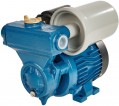Maximum particle size
The largest particle size that the pump can handle without problems. This size is the main indicator that determines the purpose of the device (see above); and in general, the larger it is, the more reliable the device, the lower the risk of damage if a foreign object enters the suction line. If the risk of the appearance of too large mechanical impurities is still high, additional protection can be provided with filters or grids at the inlet. However, such a measure should be considered only as a last resort, because from constant exposure to solid particles, the grids become clogged and deformed, which can lead to both clogging of the line and filter breakthrough.
Mechanical impurities
The maximum amount of mechanical impurities in the suction water at which the pump can operate normally (of course, if the particles of these impurities do not exceed the maximum size possible for this model; see above for details). Pure water is considered to be water with an impurity content of up to 20 g per cubic meter, but in sewage, the bill can already go to tens of kilograms per cubic meter.
pH value
The pH value of the pumped liquid for which the pump is designed. This indicator describes the level of acidity of the medium, roughly speaking, how reactive it is to the “acidic” or “alkaline” side: low pH values correspond to an acidic environment, and high pH values are alkaline. Acid and alkaline have different effects on the materials used in the construction of various equipment, including pumps. Therefore, when designing parts in direct contact with the liquid, the pH level must be taken into account, and the use of the pump with unsuitable substances is not recommended — this can lead to corrosion, which affects the composition of the pumped liquid and reduces the life of the unit. However, this parameter is critical mainly for specialized models such as pumps for chemical liquids or sewage (see "Suitable for"). In ordinary water (even dirty) the pH range is not so extensive that it cannot be covered entirely.
Country of origin
Country of origin of the brand under which the pump is marketed.
There are many stereotypes related to how the origin of goods from a particular country affects their quality. However, these stereotypes are unfounded. Firstly, this paragraph does not indicate the actual place of production of the unit, but the "homeland" of the trademark (or the location of the manufacturer's headquarters); production facilities may be located in another country. Secondly, the actual quality of the product depends not so much on geography, but on the organization of processes within a particular company. So when choosing, it is best to focus not so much on the "nationality" of the pump, but on the overall reputation of a particular brand. And paying attention to the country of origin makes sense if you fundamentally want (or do not want) to support a manufacturer from a certain state.
Water pressure tank material
The material of the water pressure tank provided in the design of the pumping station.
Recall that the classic (not sewer) pumping station is a surface pump, supplemented by a water pressure tank. Such a tank is a reservoir where water accumulates. It performs two functions: it smooths out pressure drops in the system and stores some water in case the pump is turned off. For the main body in such containers, the following materials can be used:
— Cast iron. The simplest and most inexpensive option: cast iron is somewhat inferior to stainless steel in terms of strength and corrosion resistance. However, for those models in which it is used, these moments do not have a noticeable meaning.
— Stainless steel. The most advanced material in use: stainless steel combines high strength and corrosion resistance. However, such tanks are somewhat more expensive than other varieties.
— Steel. Non-stainless steel accumulators usually use special coatings to protect against corrosion. This material is superior to cast iron in strength and is somewhat cheaper than stainless steel.
— Aluminium. The main advantage of aluminium alloys is their light weight combined with quite decent strength and rust resistance. Of the shortcomings, a rather high price can be noted.

